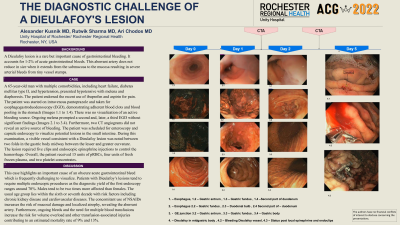Back


Poster Session B - Monday Morning
Category: Stomach
B0698 - The Diagnostic Challenge of a Dieulafoy's Lesion
Monday, October 24, 2022
10:00 AM – 12:00 PM ET
Location: Crown Ballroom

Has Audio

Alexander Kusnik, MD
Rochester Regional Health - Unity Hospital
Rochester, NY
Presenting Author(s)
Alexander Kusnik, MD1, Rutwik Sharma, MD1, Ari Chodos, MD2
1Rochester Regional Health - Unity Hospital, Rochester, NY; 2Rochester Gastroenterology Associates; Rochester Regional Health/Unity Hospital, Rochester, NY
Introduction: A Dieulafoy lesion is a rare but important cause of gastrointestinal bleeding. It is estimated to account for 1-2% of acute gastrointestinal bleeds. This aberrant artery does not reduce in size when it extends from the submucosa to the mucosa resulting in severe arterial bleeds from tiny vessel stumps.
Case Description/Methods: A 65-year-old man with multiple comorbidities including heart failure, diabetes mellitus type II, and hypertension presented with ongoing epigastric pain, melena, and diaphoresis. The patient endorsed recent use of ibuprofen and aspirin for pain. On arrival at the Emergency Department, he was hypotensive and presented with acute blood loss anemia. The patient was started on intravenous pantoprazole and taken for esophagogastroduodenoscopy (EGD), which demonstrated adherent blood clots and pooling of blood in the stomach. There was no visualization of an active bleeding source. Ongoing melena prompted a second, and later on, a third EGD without significant findings. Furthermore, two CT angiograms did not reveal an active source of bleeding. The patient was scheduled for enteroscopy and capsule endoscopy to visualize potential lesions in the small intestine. During this examination, a visible vessel consistent with a Dieulafoy lesion was noted between two folds in the gastric body midway between the lesser and greater curvature. The lesion required a total of five clips and endoscopic epinephrine injections to control the hemorrhage. Overall, the patient received 15 units of pRBCs, 4 fresh frozen plasma, and two platelet concentrates.
Discussion: This case highlights an important cause of an obscure acute gastrointestinal bleed which is frequently difficult to visualize. Patients with Dieulafoy lesions tend to require multiple endoscopic procedures as the diagnostic yield of the first endoscopy ranges around 70%. Males tend to be two times more affected than females. The usual age group lies within the sixth or seventh decade with risk factors including chronic kidney disease and cardiovascular diseases. The concomitant use of NSAIDs increases the risk of mucosal damage and localized atrophy revealing the aberrant artery. Furthermore, ongoing bleeds and the need for multiple blood transfusions increase the risk for volume overload and other transfusion-associated injuries contributing to an estimated mortality rate of 9% and 13%.

Disclosures:
Alexander Kusnik, MD1, Rutwik Sharma, MD1, Ari Chodos, MD2. B0698 - The Diagnostic Challenge of a Dieulafoy's Lesion, ACG 2022 Annual Scientific Meeting Abstracts. Charlotte, NC: American College of Gastroenterology.
1Rochester Regional Health - Unity Hospital, Rochester, NY; 2Rochester Gastroenterology Associates; Rochester Regional Health/Unity Hospital, Rochester, NY
Introduction: A Dieulafoy lesion is a rare but important cause of gastrointestinal bleeding. It is estimated to account for 1-2% of acute gastrointestinal bleeds. This aberrant artery does not reduce in size when it extends from the submucosa to the mucosa resulting in severe arterial bleeds from tiny vessel stumps.
Case Description/Methods: A 65-year-old man with multiple comorbidities including heart failure, diabetes mellitus type II, and hypertension presented with ongoing epigastric pain, melena, and diaphoresis. The patient endorsed recent use of ibuprofen and aspirin for pain. On arrival at the Emergency Department, he was hypotensive and presented with acute blood loss anemia. The patient was started on intravenous pantoprazole and taken for esophagogastroduodenoscopy (EGD), which demonstrated adherent blood clots and pooling of blood in the stomach. There was no visualization of an active bleeding source. Ongoing melena prompted a second, and later on, a third EGD without significant findings. Furthermore, two CT angiograms did not reveal an active source of bleeding. The patient was scheduled for enteroscopy and capsule endoscopy to visualize potential lesions in the small intestine. During this examination, a visible vessel consistent with a Dieulafoy lesion was noted between two folds in the gastric body midway between the lesser and greater curvature. The lesion required a total of five clips and endoscopic epinephrine injections to control the hemorrhage. Overall, the patient received 15 units of pRBCs, 4 fresh frozen plasma, and two platelet concentrates.
Discussion: This case highlights an important cause of an obscure acute gastrointestinal bleed which is frequently difficult to visualize. Patients with Dieulafoy lesions tend to require multiple endoscopic procedures as the diagnostic yield of the first endoscopy ranges around 70%. Males tend to be two times more affected than females. The usual age group lies within the sixth or seventh decade with risk factors including chronic kidney disease and cardiovascular diseases. The concomitant use of NSAIDs increases the risk of mucosal damage and localized atrophy revealing the aberrant artery. Furthermore, ongoing bleeds and the need for multiple blood transfusions increase the risk for volume overload and other transfusion-associated injuries contributing to an estimated mortality rate of 9% and 13%.

Figure: 1.1 – Dieulafoy lesion in midgastric body
1.2 – Bleeding Dieulafoy vessel
1.3 – Status post local epinephrine injection and use of endoclips
1.2 – Bleeding Dieulafoy vessel
1.3 – Status post local epinephrine injection and use of endoclips
Disclosures:
Alexander Kusnik indicated no relevant financial relationships.
Rutwik Sharma indicated no relevant financial relationships.
Ari Chodos indicated no relevant financial relationships.
Alexander Kusnik, MD1, Rutwik Sharma, MD1, Ari Chodos, MD2. B0698 - The Diagnostic Challenge of a Dieulafoy's Lesion, ACG 2022 Annual Scientific Meeting Abstracts. Charlotte, NC: American College of Gastroenterology.
